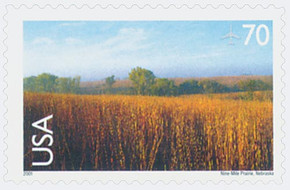
U.S. #C134
1999 40¢ Rio Grande
Scenic American Landscapes
Issue Date: July 30, 1999
First City: Milwaukee, Wisconsin
Quantity Issued: 100,750,000
Printed by: Avery Dennison
Printing Method: Photogravure
Perforation: Serpentine Die Cut 11
Colo... more
U.S. #C134
1999 40¢ Rio Grande
Scenic American Landscapes
Issue Date: July 30, 1999
First City: Milwaukee, Wisconsin
Quantity Issued: 100,750,000
Printed by: Avery Dennison
Printing Method: Photogravure
Perforation: Serpentine Die Cut 11
Color: Multicolored
The second installment in the Scenic American Landscapes Series pictures the Rio Grande River, which marks the boundary between Texas and Mexico. The 40¢ denomination of this stamp fulfilled the 1999 international rate for a postcard mailed from the United States to Mexico.
Fort Bliss
On November 7, 1848, the War Department established a post on the Rio Grande that would later come to be known as Fort Bliss.
General Zachary Taylor established a military camp at the Rio Grande to protect American interests in the territory also claimed by Mexico. This helped provoke the Mexican-American War, in which Taylor was a key commander.
After the conclusion of the Mexican-American War, the US government quickly recognized the need to defend its new border. They also sought to provide law and order, protect settlers and those traveling to California from Native American attacks, and to survey for the new transcontinental railroad.
To aid in these tasks, the War Department issued General Order no. 58, establishing a military post on the Trio Grande near El Paso del Norte (present-day Ciudad Juárez, Chihuahua). The Third Infantry would be placed in charge of the post, with Brevet Major Jefferson Van Horne commanding the 257 soldiers to be sent there. The troops arrived at the post the following September and some of them occupied the presidio at San Elizario south of El Paso.
Just two years later, the War Department closed the post and the Presidio, moving the troops 40 miles north to Fort Fillmore. The post on the Rio Grande would be reestablished in January 1854 when Lieutenant Colonel Edmund Brooke Alexander and four companies of the Eighth US Infantry returned. On March 8 of that year, it was renamed Fort Bliss, after Lieutenant Colonel William Wallace Smith Bliss, General Zachary Taylor’s chief of staff during the Mexican American War who would also later become his son-in-law.
Seven years later, the US Civil War broke out and forced officers and enlisted men in western posts to choose sides and go their separate ways. After Texas withdrew from the Union, Federal troops remaining at Fort Bliss were ordered to surrender to Confederate forces on March 31, 1861.
Under Confederate control, Fort Bliss was used as a platform to launch attacks into New Mexico and Arizona in an effort to force Union troops in the area to surrender. The Confederates were succeeding in New Mexico until the Battle of Glorieta Pass.
On March 26, 1862, Confederate Major Charles L. Pyron led an advance expedition over Glorieta Pass. Control of the strategically located pass would enable the Confederate Army to move onto High Plains and attack Fort Union, a Federal stronghold. But the leader of the Union’s 2nd New Mexico Infantry spotted the Confederate supply train, which was vulnerable to attack. His forces looted and set fire to eighty supply wagons, spiked the cannon, and eliminated 500 horses and mules. The Confederate troops were forced to retreat.
The Confederates destroyed Fort Bliss as they retreated, except for the hospital that housed their sick and wounded. The post was not re-garrisoned by Union forces until after the war ended in 1865. During this time, hostile Indians took advantage of the lack of protection, stepping up attacks and driving many settlers out of the area.
Over the years, Fort Bliss was rebuilt and moved several times. Its mission has changed many times, as well. The Buffalo Soldiers were stationed there in the late 1800s and John Pershing went there in the 1910s as part of the Pancho Villa Expedition. In 1921, it hosted its first artillery unit.
During World War II, the fort grew from a few thousand acres to over a million. Fort Bliss was one of the first American military bases to test rockets and train people in their use. In 1946, many of the German scientists freed by US spies in World War II were stationed at Fort Bliss. Today, Fort Bliss houses the US Army Air Defense Artillery Center and School. The fort’s firing range includes 1.2-million acres of land in Texas and New Mexico. This land is used to teach troops how to use anti-aircraft artillery and guided missiles. It’s the second-largest US Army installation in the world.
Less
Please Try Again
This webpage is experiencing a large amount of traffic. Please try again later.
Please Try Again
This webpage is experiencing a large amount of traffic. Please try again later.
Please Try Again
This webpage is experiencing a large amount of traffic. Please try again later.

Most Orders Ship
within 1 Business Day
90 Day Return Policy
Satisfaction Guaranteed
Earn Reward Points
for FREE Stamps & More











